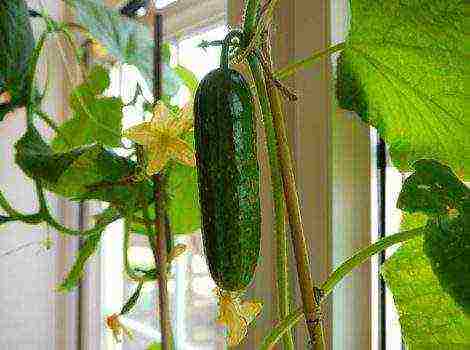Content [show]
Today it has become possible to grow grapes in the Leningrad Region, and caring for the plant is not particularly difficult. Gardeners are quite successful in growing this thermophilic crop not only in greenhouses, but also in the open field. The main thing is to choose the right grape varieties and provide proper care.
The best varieties for open ground
Amurskiy
Not all grapes can be grown outdoors in the Leningrad Region. First of all, the varieties must be frost-resistant, with a very early and early ripening period. Thus, the grapes should ripen by mid-August. Even a cool summer will not be a hindrance to early and very early varieties. If we compare ripening in the greenhouse and in the open field, then in the greenhouse the fruits will mature twenty days earlier.
The main feature of Amursky grapes is resistance to frost and fungal diseases. Outwardly, this variety resembles a wild liana, on which there are weighty bunches. He is not afraid of transplants and easily adapts to different conditions. Amur grapes are often compared to wild grapes. In autumn, its fiery red foliage adorns the area, and at the moment of ripening, you can enjoy the excellent sweet taste of the berries.
Muscat
This variety belongs to the technical table, it can be eaten and made excellent wines from it. The bunches are approximately 10 cm long and 8 cm wide with a yellow-golden hue, round fruits with thin skin and juicy flesh with a great nutmeg aroma.
The seedlings have unique properties: they are resistant to diseases, severe winters, and have good adaptive properties. The variety has a high stable yield, long-term storage of fruits on the shoots, which allows it to have a good presentation during transportation. Shoots develop well, ripening up to 90%.
Zilga
It is a versatile early ripening variety. Large oval blue fruits can be eaten at the end of July - beginning of August. The bunches are cylindrical and dense in structure. A feature of Zilga grapes is the ability to maintain excellent taste and presentation, even when the bunches remain on the bushes for a long time.
This variety is frost-resistant and can be grown without the use of shelters, resistant to lesions by gray mold and oidium. The variety is planted in spring or autumn. Seedlings are undemanding to the composition of the soil. The grapes have great vigor of growth, therefore they need support.
Aglaya
The grapes have dense clusters weighing up to 400 g. The berries are medium-sized, green in color, have an exquisite taste. The variety is resistant to low temperatures and easy to care for.
The best varieties for a greenhouse
Laura
The grape is a table variety and has a slightly sugary taste with a hint of nutmeg. In fact, the official name of the grape is "Flora" and it differs in that the fruits are well preserved both on the bushes and after harvest, due to the very strong fastening of the berries to the stalk.Outwardly, the grapes look great: huge clusters weighing a kilogram, ripe light oval berries. The fruits have a dense, juicy and sweet pulp.
Grapes grow in 120 days. The variety is high-yielding - up to 40 kg can be harvested from one bush. The variety is unpretentious, and despite the fact that it loves a warm climate, it tolerates cold weather very well. The main problem, which he cannot cope with on his own, is powdery mildew, therefore one of the necessary measures is treatment with special chemical agents.
Kishmish
The Kishmish grape is seedless. He is good at making raisins. One of the best varieties - "Radiant", which is considered a masterpiece among raisins, outshines all seedless varieties in beauty and taste. Feels great in greenhouse conditions, just do not forget to spray.
Arcadia
Arcadia is a variety that is resistant to low temperatures and has excellent fruit quality and disease resistance. Early variety. The berries are amber or white in color and have a fairly simple taste with a slight nutmeg aroma. The grapes are able to withstand frost down to -26 ° C under a film. The variety has a high yield.
Landing rules
We already know the best varieties. Now we will figure out how to grow grapes correctly so that it gives a constant and bountiful harvest. For one bush, you need an area of two meters in length and half a meter in width. It is necessary to plant grapes on a hill in a sunny place. For example, choose an area near the wall so that it, having warmed up during the day, can transfer its heat to the bush at night.
If the groundwater is close to the surface, then it is better to "raise" the site. Just do not dig to the clay layer, otherwise the seedlings may die. The area where the planting of grapes is planned must first be fertilized with organic and mineral fertilizers. Another important point: grapes do not like acidic soil.
Given the peculiarity of the soil in the Leningrad Region, a little lime must be added to the planting pit.
Features of growing and care
Pruning and reproduction
If you decide to grow grapes in the Leningrad region, then planting and care require certain skills. The planted bushes will bear the first fruits only after four years. The grower will have to take care of growing the vine.
In the northern regions, even non-covering varieties will have to be covered with special material at the beginning of May, since they need 3-4 months to ripen, and in the Leningrad region there are no frosts for only 2.5 months. Pruning of the bushes is carried out annually: in the fall, six buds are left on the sleeve, and in the spring - three. The vine takes four years to form.
Grapes propagated by cuttings. It is necessary to harvest cuttings in the fall before the first frost. The cuttings are cut and stored in the sand until spring, and in the spring they are placed for kilchev. The first roots will appear in a couple of weeks. Then the cuttings are planted in the garden so that they grow.
Watering and feeding
It is not enough to properly plant the grapes and form the vine. The plant still needs to be fertilized and watered. Top dressing is not required only in the first two years of vine growth. Already from the third year, fertilizers and humus are applied under the bush, and in the spring - lime or ash. When the first fruits appear, the grapes will need potash fertilization by the end of summer. Watering the bushes is often not worth it, especially if the humidity is high. It is enough for a shrub to receive watering 4–5 times during the entire development and maturation period.
Disease and pest control
The care of grapes also includes the prevention of diseases that this plant is susceptible to. Diseases and various parasites can very quickly destroy the entire crop, if they are given free rein. The main diseases of grapes include:
- mildew;
- gray rot;
- oidium.
To reduce the risk of catching any disease, it is necessary to provide adequate ventilation, and also to treat the vine with special preparations as a prophylaxis.Although not only bushes are subject to processing, but also the soil.
For pests such as spider mites, grape leafworm, phylloxera and grape itch, grapes are sprayed with fungicides in autumn and early spring.
Viticulture in the Leningrad Region is no more complicated than in the southern regions. When you take into account the peculiarities of the climate and soil, ensure proper care of the bushes and control pests and diseases, you will get a rich and tasty grape harvest.
Video "Planting grapes and care"
In this video, you will learn how to plant and care for grapes.
There are quite a lot of those crops that are usually called by gardeners and truck farmers, southern. Those who are lucky enough to live in regions with a warm climate can grow melons, apples and grapes.
For some time now, residents of colder regions remained deprived. Now, thanks to selection, it has become possible to grow grapes in the Leningrad region. And this process is going pretty well. At the same time, special efforts are not expended, and care can be reduced to almost a minimum.
Of course, if you approach the matter correctly and thoroughly. But how to do it - will be described below.

What to choose - open ground or protected space
Usually grapes are grown outdoors. The Leningrad Region is also engaged in this. And with some success.
It is believed that for southern crops, which grapes are, a space protected from cold weather, that is, a greenhouse, is suitable. Although today they practice cultivation of those early varieties that were bred taking into account severe frosts. Moreover, they are cultivated in the open field.
Each of the above methods has its positive and negative sides. The advantages of greenhouse cultivation include:
- timely ripening of the crop;
- the berries are juicy and very sweet;
- you can choose any varieties for growing.
The disadvantages of this growing method include the early awakening of the kidneys (they can freeze), regular watering and the risk of developing certain diseases due to constantly high humidity and high temperatures.
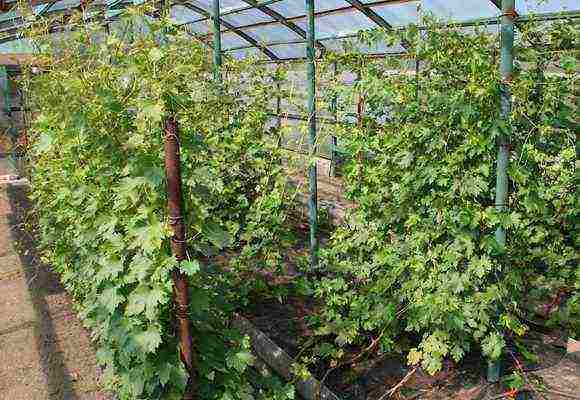
Growing grapes without a special shelter in the Leningrad Region is quite problematic when it comes to most varieties. For this process, only those that ripen too early are suitable. And with medium-sized berries on bunches. The larger ones will not have time to ripen.
What varieties to choose for open ground
The choice of a variety for planting in the open field should be based on the above criteria. Experienced growers recommend the following varieties for this:
- Super early variety Spulga - it is able to withstand up to 27 degrees of frost.
- Vigorous table grapes Agate Donskoy - resistant to severe frosts and most diseases.
- A very early variety Zilga - universal, resistant to rot, mildew, etc. Early ripening - in early August.
- Early variety White pearl - vigorous, ripens towards the end of summer. Differs in high productivity.
- The technical grade Alpha is vigorous, it is used as a planting material, the berries are processed.
Experienced winegrowers and grape bushes of the following varieties are recommended: Taezhny, Yadviga, Korinka Russkaya, Moskovsky steady and others.
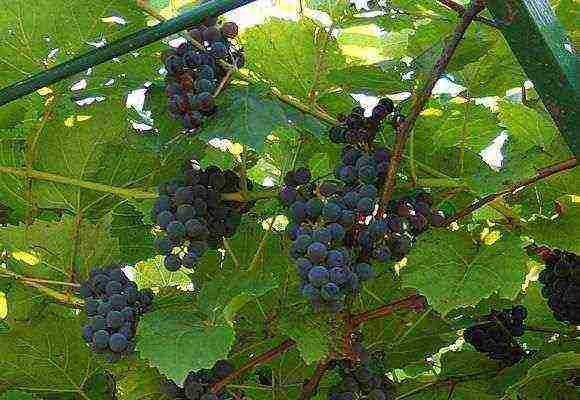
Greenhouse varieties
The cultivation of grapes, carried out under greenhouse conditions in the Leningrad region, requires the use of certain varieties. Such, for example, as:
- early-middle table variety - Radiant Kishmish;
- very early table variety - Laura;
- A very early variety for dining purposes - Russian early.
How to plant grapes correctly
When grapes are grown in the Leningrad region, certain planting and care will be needed.
Cultivation begins with choosing a planting site. It should be well lit by sunlight and located on a hill.For example, at the wall of one of the homestead buildings.
This must be done so that at night the wall heated during the day gives the bush its warmth. Mature grapes occupy a rather impressive area - 1–2 linear meters in length and half a meter in width.
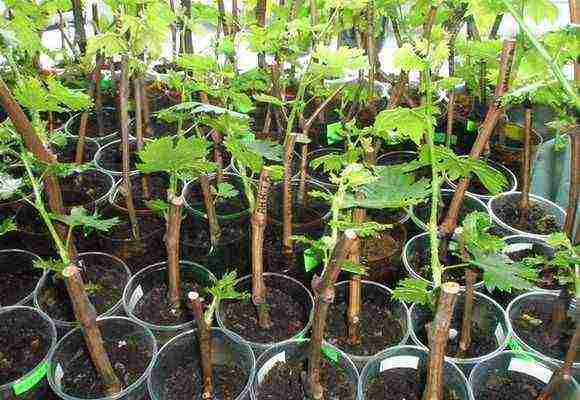
A high water table will require some soil elevation. To do this, you can use gravel for drainage, as well as compost and soil. Similar actions should be performed even if the fertile layer is not deep enough. And the hole should not be dug to the clay, as the seedlings may die in it.
Pre-planting site should be supplied with fertilizers. This is done in the spring, organic matter and fertilizers are introduced into the ground, then dug up. Useful substances should be located at a depth of about 40 cm, and the diameter of the fertilized area should not be less than 2 meters.
The seedlings are placed in a permanent place in the summer, the roots should be open when planting. The heel roots are deepened into the ground by 30 centimeters. The grapes are planted in autumn.
How to grow and care properly
Viticulture in the Leningrad Region requires some special skills. To get a harvest in four years, you will need to properly care for the vine, and how to grow it more.
In the first year of life, the seedling forms a root system. At the same time, the vine grows weakly, when it is pulled it needs to be pinned. There are no special care measures, only shelter for the winter is needed.
In the second year of life, grapes are opened early. Otherwise, the buds wake up early and freeze under the rule of the spring frost. Shoots should be examined, the strongest should be selected, in the amount of 2-3, and the rest should be removed. In the summer, the stepsons that appear must be broken out. In winter, re-shelter will be needed.
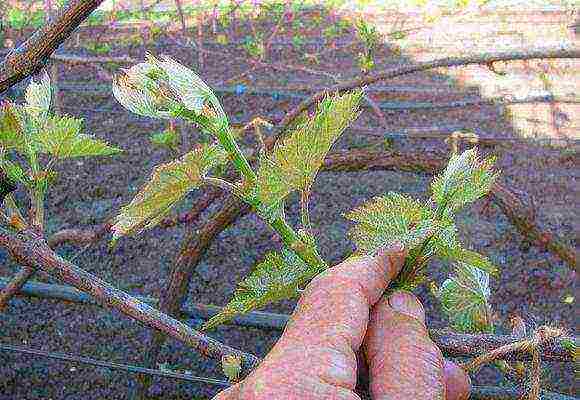
In the third year, those sleeves (the shoot closest to the base of the vine) that have successfully wintered are already tied horizontally to the trellis. Shoots are knitted vertically. This is the period when the grape bush is fully formed, so you need to act carefully at this time.
Preparing grapes for winter this year consists in pruning the vines in the fall. Only what will be used for replacement and harvesting is left. Pruning is carried out on 4 and 12 eyes.
Fruiting begins in the fourth year. Extra brushes that will create overload will need to be removed. Care at this time is standard.
Top dressing and fertilization
The grapes will not need fertilization for the first two years after planting. But already on the third, it will be necessary to add humus and potassium-phosphorus fertilizers. With the onset of heat, lime or wood ash is also added.
The grapes will need feeding during the fruiting period. Potash fertilizers are applied directly under the roots, this should be done in August.
How to propagate grapes in such conditions
You can propagate grapes in the Leningrad Region in the same way as in other regions, and in the same ways. There are two of them - reproduction by layering and reproduction by shanks.
The shanks are harvested during pruning, in the autumn. The main condition for obtaining high-quality planting material is a ripe vine. This is determined by inspecting the cut - the core there will be greenish.
Germinate in February by placing the shanks in a container of water. Leaves usually appear before roots, so they should be protected from drying out. When the roots appear, the shanks are placed in fertile loose soil, the container is placed on the windowsill.
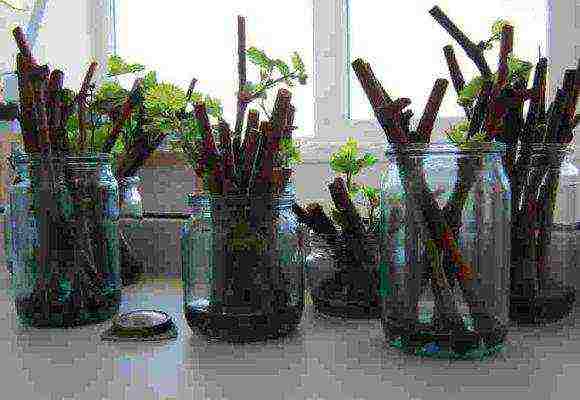
The simplest propagation method is recognized as the one that allows the use of grape layers as a new planting material. It is very easy to get it - to dig in the shoots by 20-30 cm in the fall, breaking off the stepchildren and foliage from them in advance. The top should rise above the ground. Young shoots will appear next year, a new bush will form a little later.
Diseases and pests
Diseases of grapes are the scourge of all those who have devoted many years to growing this berry. The invasion of pests is also added here. So the picture is rather unpleasant. And if you run these misfortunes, you can completely lose both the harvest and the bush itself.
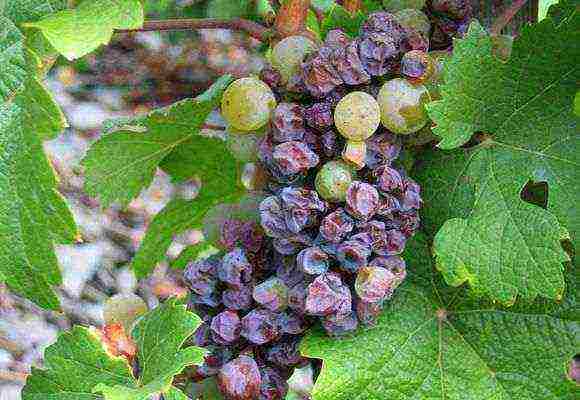
The main diseases are called sulfur rot, powdery mildew, or mildew. Increased humidity contributes to their appearance. Among the pests, the grape leafworm and spider mite are known.
For prevention, it is recommended to treat grape bushes in early spring and autumn, after harvest, with fungicides.
The difficulties associated with growing grapes in the Leningrad region are no more than if the cultivation was carried out in the southern regions.
The main thing is to surround this culture with the necessary care and proper care. And then a tasty, plentiful and, most importantly, high-quality harvest will be a reward for the time spent and the efforts put into the cultivation and care process. And tasty and juicy berries can be used both for their intended purpose - for food, and for sale.
After all, grapes are recognized as one of the most demanded on the shelves of markets and shops, cultures. And almost everyone loves him.
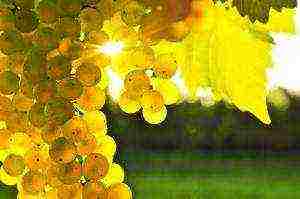 Many gardeners do not plant grape bushes on their backyards, as they think that growing this crop in the Leningrad Region is a rather laborious process. This judgment can hardly be called true. If you choose the right grape varieties, carry out the correct planting of shrubs, and provide the culture with proper care, then the process will be simple, and the harvest will be excellent.
Many gardeners do not plant grape bushes on their backyards, as they think that growing this crop in the Leningrad Region is a rather laborious process. This judgment can hardly be called true. If you choose the right grape varieties, carry out the correct planting of shrubs, and provide the culture with proper care, then the process will be simple, and the harvest will be excellent.
The value of grapes
Grape fruits contain numerous vitamins and valuable nutrients that the human body needs. It was this berry that was noted by the ancient Slavs as the berry of life, well-being in the family and prosperity. Processed grape juice and pulp are used in the medical field of activity and in pharmacology.
The shrub is classified as a heat-loving culture, so it is often grown in southern latitudes. But thanks to the development of science, breeders have received special grape varieties, which can be grown in the Leningrad region, and it is really possible to plant shrubs both in open ground and in greenhouses.
What are the requirements to consider when planting a shrub
You can get a good harvest of grapes from your own personal plot in the Leningrad Region if you adhere to the basic planting requirements:
- Plant a crop in fertile soil.
- Choose the most optimal landing site.
- Purchase suitable crop varieties.
- Properly care for the seedlings.
If all the requirements are taken into account, both novice gardeners and experienced gardeners will be able to get a good harvest of tasty, vitamin berries.
How to properly prepare the soil for planting
The grapes are not too whimsical to the quality of the planting land, however, this culture will not grow well and yield a harvest if you choose clay soil. Growing grapes is best done in fertile black soil, to which small amounts of sand will be added. If the soil contains a lot of clay, then before planting the shrub, additional components in the form of sand and fertile soil should be introduced into the ground, supplementing the mixture with a drainage base.
In the sandy soil, you need to add organic fertilizers in the form of rotted house manure, reduce the acidity of the soil with ordinary lime.
Growing grapes will be successful if the planting site is selected on a hill. In such an area, the accumulation of a large amount of moisture is excluded, which can destroy the root system of plants.
Planting culture
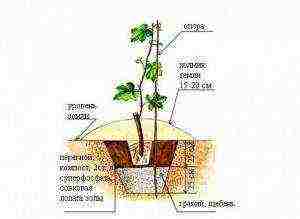 Before planting a young shrub, you should carefully choose a planting site. The best place for growing is the southern part of the site, which is protected on one side by a building.In such a place, young plantings will take root perfectly, they will receive the necessary heat and sunlight throughout the summer. Thus, by the cold season, the shrub will be able to get stronger, its root system will be well strengthened.
Before planting a young shrub, you should carefully choose a planting site. The best place for growing is the southern part of the site, which is protected on one side by a building.In such a place, young plantings will take root perfectly, they will receive the necessary heat and sunlight throughout the summer. Thus, by the cold season, the shrub will be able to get stronger, its root system will be well strengthened.
See also: How to spray grapes before budding
If there is no free space on the south side, then you need to make the landing hole in a deeper version, that is, dig it about 15-20 centimeters deeper. The most important thing when planting is to be able to preserve the root system of the grapes, this is the only way a new green plantation can survive and begin to develop.
What varieties are best to choose for planting in the Leningrad region
Currently, the consumer is able to choose from a variety of grape varieties that can be grown in the Leningrad Region. In this case, the following indicators should be taken into account:
- ripening period of berries;
- sufficient frost resistance of plantings;
- features of care.
The ripening period of the fruits should occur when the region will have the warmest and not rainy weather. And sufficient frost resistance will help the shrubs to winter safely, in the spring it is good to grow.
The most popular varieties are the following:
- Amursky.
- Muscat.
- Zilga.
- Aglaya.
If the cultivation of grapes will take place in a greenhouse, then you should opt for varieties:
- Laura;
- Kishmish;
- Arcadia.
Experienced gardeners recommend that the vineyard be protected from frost and winds, regardless of the selected varieties for planting. It is quite simple to hold such an event, for this the vine of the bush is simply lowered to the ground and pressed with a small support. A burlap-shaped shelter should be placed on top of the vine, and as soon as the first snow falls, it should be covered with snow. So that the vine does not begin to ripple as soon as the snow melts, it is necessary to immediately remove the shelter. In case of promised frosts, it is recommended to treat the plantings with special preparations, for example, EcoFus or Epin.
How to properly plant young cuttings
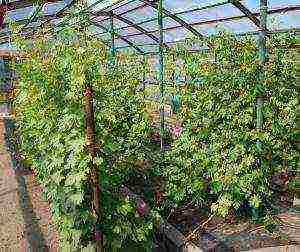 Growing grapes is mainly about growing cuttings. After the small twigs of the shrub give leaves and their root system gets stronger, you can independently plant the planting material in the ground. However, you can get a good harvest of berries if the cultivation of plantings and care takes place in stages:
Growing grapes is mainly about growing cuttings. After the small twigs of the shrub give leaves and their root system gets stronger, you can independently plant the planting material in the ground. However, you can get a good harvest of berries if the cultivation of plantings and care takes place in stages:
- the landing hole should be 75-80 centimeters in both length and width;
- it is imperative to lay a drainage layer on the bottom of the recess; ordinary crushed stone or crushed brick can be used as drainage;
- the drainage is covered with earth, rotted manure, organic and potash fertilizers are added to it. Everything is thoroughly watered with settled water;
- as soon as the water is saturated, a recess is made in the center of the planting hole, into which the root system of the cutting is neatly placed;
- the top layer of soil is compacted, a small support is installed for planting. As a support, you can use a metal product in the form of reinforcement or wire;
- growing will not be effective if cuttings are planted too close to each other, so a distance of about one meter should be maintained between the planting holes.
Cuttings are best planted in open ground in spring, when the soil warms up enough, if this event is carried out in the fall, then the plants must be protected from frost and winds, and the shelter will need to be made strong and reliable.
Additional recommendations
Cultivation of a culture in the Leningrad region, as you can see, is not such a difficult process, however, after planting, you need to take care of the grapes further:
- control soil moisture throughout the summer period. Do not water the grapes often, especially if the weather is humid.It will be enough for a shrub to receive abundant watering 4-5 times during the entire period of development and ripening;
- with the onset of autumn, you need to cut off excess shoots so that no more than four, but the strongest branches remain on the bush. On adult plants, pruning should be carried out regularly so that the bush does not have damaged and old shoots;
- in the summer, weed should be eliminated, the topsoil should be constantly loosened. If during processing you notice bare roots, they must be covered with soil so as not to allow the root system to dry out from the heat. The cultivation of a vineyard will be much more effective if the necessary fertilizers and trace elements are introduced under the shrub.
Taking into account all the recommendations provided in this article, everyone can independently plant, grow and get an excellent harvest of a valuable berry, which is called grapes.
Attempts to accomplish something, at first glance, impossible, are viewed by many with disapproval: they say, this violent energy would give a useful channel. So this is exactly what we are talking about!
Here's an example worthy of emulation.
The benefits of peeping
Studying articles about grapes, I noticed that their authors live in warm regions, only one article was from a summer resident from Karelia.
Yes, a brave man, respect him and respect. That is why I want to support him, and at the same time to encourage everyone who doubts their abilities. I also live in a region famous for its kooky weather. And in such a difficult climate, I successfully grow grapes in the open field. “Adventurer,” you say. Maybe!
The photographs showing the result of my work testifies to the fact that for us, summer residents, nothing is impossible. What has this gamble to do with it?
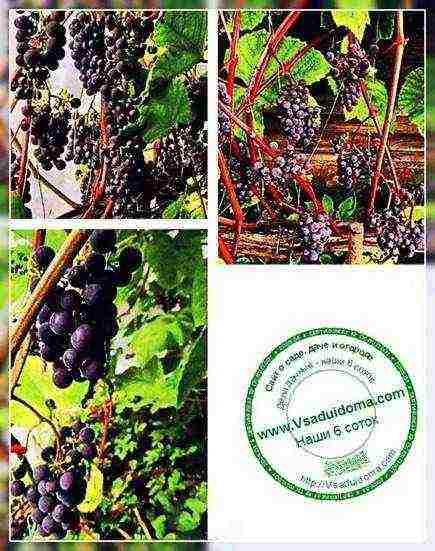
Acquaintance with this culture began with a strange plant no more than 1 m high and light green foliage seen through a neighbor's fence: either a mad cucumber, or some kind of flower on a decorative lattice - you cannot tell from a distance. I didn’t understand much, I shrugged my shoulders, and that was all.
And three years later, this plant grew among neighbors along the entire facade of the house, and only then I realized that it was grapes. Well, you must! I went to the hostess to inquire whether this miracle is not of our nature bearing fruit or not. And if so, are the berries edible? And I was even more surprised to learn that the neighboring grapes both bear fruit and produce tasty berries, and they ripen completely, despite our northern summer (which, as Pushkin said, is a caricature of southern winters).
See also: Growing Amur grapes in the Leningrad region
And most importantly, it does not require capital shelter (and care too) - for the winter, they wrap the whips in a covering material and lay them on the ground. That's all the work.
Cut it, but be wise I, of course, in the spring begged for three cuttings for divorce and planted them, too, along the southern facade of the house. By the next year, only one sapling of this trinity survived, but it began to grow intensively and in a season gave a vine more than a meter long.
From the articles I learned that it needs to be cut in the fall by 3-4 buds. And so she did. And the next summer I already had three vines. Before freezing, I shortened them a little, covered them with spruce branches and non-woven material, pinning them to the ground with arches.
In the third year, the grapes produced new vines with clusters of flowers (each branch had 2-3 clusters). In order not to overload the bush, I left one brush at a time. During May, she threw a film over the grapes, fearing recurrent frosts. In June, she stopped doing this, and the bush turned desperately green, releasing more and more new shoots. In July, they turned into a real jungle: I had to break something out, pinch something.
In August, I cut off all the shoots at the level of the upper thread of wire (by that time, a trellis had already been made of two posts with three rows of strings between them), and in September I tried my own grapes for the first time. The bunches, however, grew small, there were few berries on them (still
and turned out to be with bones, not too sweet), but what a joy all my household experienced from the fact that in our difficult climate it is possible to grow a wonderful southern culture!
After the frost, it was necessary to prune the vines, and although I read about pruning, I did not understand everything. What to remove, what to leave? She cut at random, choosing the thinnest branches. Satisfied with herself, she covered the bush, laying it on the ground. And in the spring I was very glad that he came to life, letting his buds grow. But further ...
Then many shoots grew, but there were only two tassels of flowers. What's the matter? I sinned about the weather and calmed down, because now nothing can be fixed anyway. In the fall, I began to surf the Internet, read notes, watched videos about cropping, and only then I realized my mistakes.
Turns out, the vines that bear fruit had to be cut completely, and leave annuals for fruiting. And I didn't even mark them, I cut everything with one brush - that's the result.
See also: Growing a walnut tree in the Leningrad region
Having received the information, I tried to carry out the pruning according to all the rules. The pile of removed branches turned out to be impressive, but this did not bother me, since, according to experienced growers, up to 90% of the wood is removed during pruning. She covered the half-bald bush and laid it on the ground. Then I thought about it and for some reason covered it with spruce branches, and on top I made huts made of foam.
And how I felt! The winter that year was just horror: 30 ° frost, and there was not a snowflake on the ground. Half of the strawberries then froze, and at least henna grapes! And what kind of harvest I had that summer (it also turned out to be cold), you can see in the same photo.
So, dear summer residents, everything in the garden and the garden depends only on your desire. And it will come and experience with ingenuity. The road will be mastered by the walking! Good luck to everyone in our difficult, but such exciting work!
Below are other entries on the topic "Cottage and garden - do it yourself"
Grapes in the Urals - planting and care: Cuttings of grapes and their planting ... Growing Amur grapes in the Leningrad region: Amur grapes in St. Petersburg: history ... Reforming grapes: How to reform grapes. Guyot system Season ... Grapes Memory of Dombkovskaya (photo) - cultivation of this variety in the North: Memory of Dombkovskaya (BCHZ) - variety ... Fight against oidium - methods and means: my feedback about them: Oidium of grapes - as with ... Care of grapes: calendar: Vineyard care calendar
Subscribe to updates in our groups.
Let's be friends!
